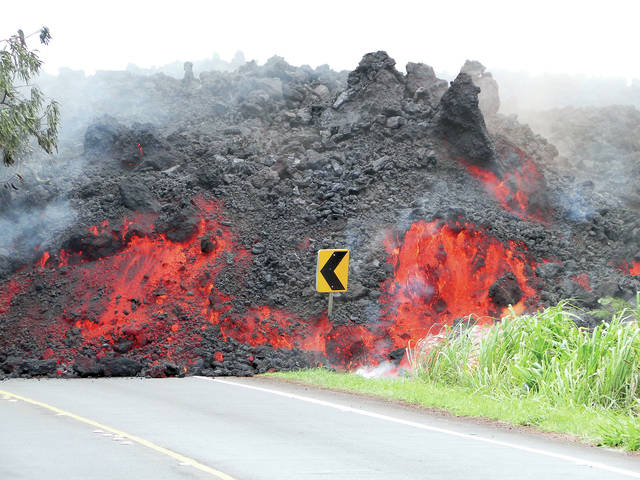Since the end of the 2018 lower East Rift Zone eruption on Kilauea Volcano, questions surfaced concerning how long it will take for the new lava flows to solidify. This is a difficult question to answer because the initial eruptive temperatures — along with many different factors — can influence the rate of cooling.
Eruptive lava temperatures of the 2018 LERZ eruption reached a maximum of approximately 1,140 degrees Celsius (2,080 degrees Fahrenheit). When the entire flow cools to below about 1,000 degrees Celsius (1,800 degrees Fahrenheit), it has solidified, but the interior is still very hot.
Arguably the most influential factor determining how fast lava cools is the thickness of the flow. Other factors include heat loss from the top (to the atmosphere) and bottom of a flow (into the ground). Contributing to heat loss at the flow’s surface are air temperature, rainfall and wind.
The initial contact between a lava flow, the air above it and ground surface below it quickly hardens its outer crust (top and bottom). This is apparent in the silvery crust that forms on active pahoehoe flows and the rubbly clinker that surrounds active ‘a‘a flows. As the crust cools and thickens, it retains heat within the flow’s interior. This is because the crust is a good insulator, meaning it poorly conducts heat — similar to how an insulated thermos keeps liquid inside hot.
After the initial formation of crust, the flow continues to lose heat through radiation and conduction, facilitated by wind and rain. As rain water percolates into cracks in the flow’s surface and encounters the hot interior, it produces steam, forming the billowy white plumes often seen over active (or recently active) flows. This steaming can persist for decades, long after the lava solidifies, depending on the thickness of the flow and the temperature of its interior.
Based on a study of crustal cooling of pahoehoe lava flows in Kalapana erupted from the East Rift Zone Kupaianaha vent in 1990, we can estimate the solidification time for the 2018 LERZ flows. Because the equation only looks at cooling of the lava flow’s upper crust, the basal crust thickness is assumed to equal 70 percent of the upper crust, according to this study.
The Kalapana measurements were made on thin pahoehoe flows, but most of the 2018 LERZ lava is ‘a‘a. But because the core of each flow type should cool at similar rates, we are basing 2018 cooling rates on the 1990 study. Also of note, the flows studied in 1990 were much thinner with shorter cooling rates and might not account for long-term changes in wind and rain patterns.
Preliminary analyses of the 2018 LERZ eruption flow thicknesses suggest the average flow thickness is about 10-15 m (33-50 ft). Based on the cooling rate calculation, it could take roughly eight months to 1 1/2 years for flows of these thicknesses to solidify.
Solidification of flows ranging from 20-30 m (65-100 ft) thick could take about 2 1/2 to 6 years. The thickest LERZ flows on land, which are about 55 m (180 ft) thick, might take roughly 20 years to reach a completely solid state.
Because flow thickness, wind speeds, rainfall amounts, air and ground temperatures and other factors all affect lava cooling rates, there is a range of uncertainty on how long the interior of a flow remains liquid. For example, after the 1959 Kilauea Iki eruption, the approximately 135 m (440 ft) deep lava lake took about 35 years to completely solidify, and the interior of the lake could still be hot enough today that the rock is incandescent. This is why, on rainy days, you can see steam rising from the Kilauea Iki crater floor, as well as the Kilauea caldera floor.
With flow crust being such an efficient insulator, it can take years to decades for lava within thick flows to solidify. It takes much longer for the flow to cool to ambient temperatures.
Next week’s Volcano Watch will address in more detail the thicknesses of lava flows from the 2018 LERZ eruption.
Volcano activity updates
Kilauea is not erupting. Rates of seismicity, deformation and gas release have not changed significantly during the past week.
Two earthquakes with three or more felt reports occurred in Hawaii during the past week: a magnitude-3 quake 7 km (4 mi) south of Leilani Estates at 8 km (5 mi) depth at 2:31 a.m. Feb. 22 and a magnitude-3.2 quake 17 km (11 mi) southeast of Volcano at 7 km (4 mi) depth at 11:32 a.m. Feb. 21.
Deformation signals are consistent with refilling of Kilauea Volcano’s deep East Rift Zone magma reservoir. Sulfur dioxide emission rates on the ERZ and at Kilauea’s summit remain low.
Hazardous conditions still exist at the lower ERZ and summit of Kilauea. Residents and visitors in the lower Puna District and Kilauea summit areas should stay informed and heed Hawaii County Civil Defense closures, warnings and messages (http://www.hawaiicounty.gov/active-alerts). HVO continues to closely monitor Kilauea for any sign of increased activity.
The USGS Volcano Alert level for Mauna Loa remains at Normal.
Visit HVO’s website (https://volcanoes.usgs.gov/hvo) for past Volcano Watch articles, Kilauea and Mauna Loa updates, volcano photos, maps, recent earthquake info, and more. Call 808-967-8862 for weekly Kilauea updates. Email questions to askHVO@usgs.gov.
Volcano Watch (https://volcanoes.usgs.gov/hvo/hvo_volcano_watch.html) is a weekly article and activity update written by U.S. Geological Survey Hawaiian Volcano Observatory scientists and affiliates.






